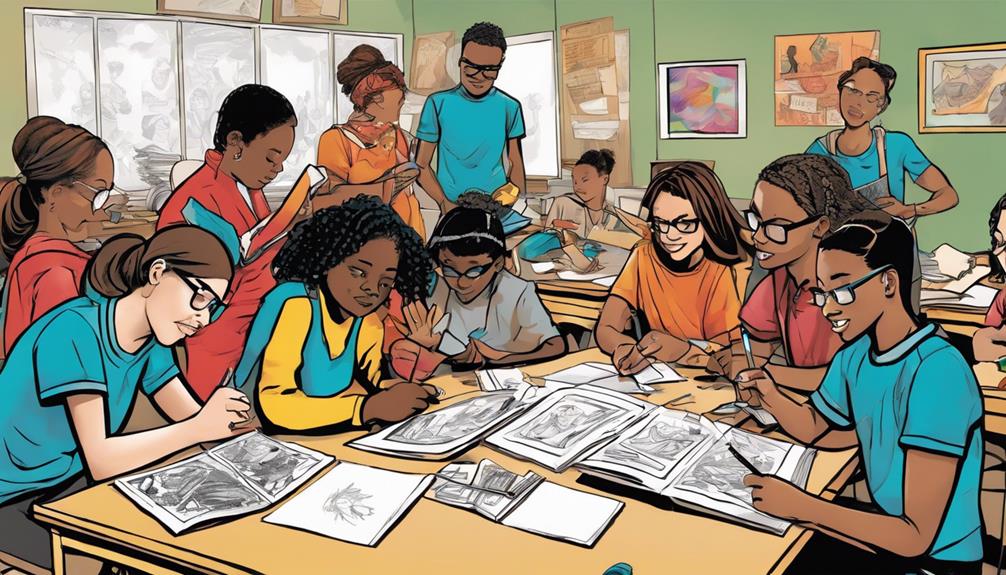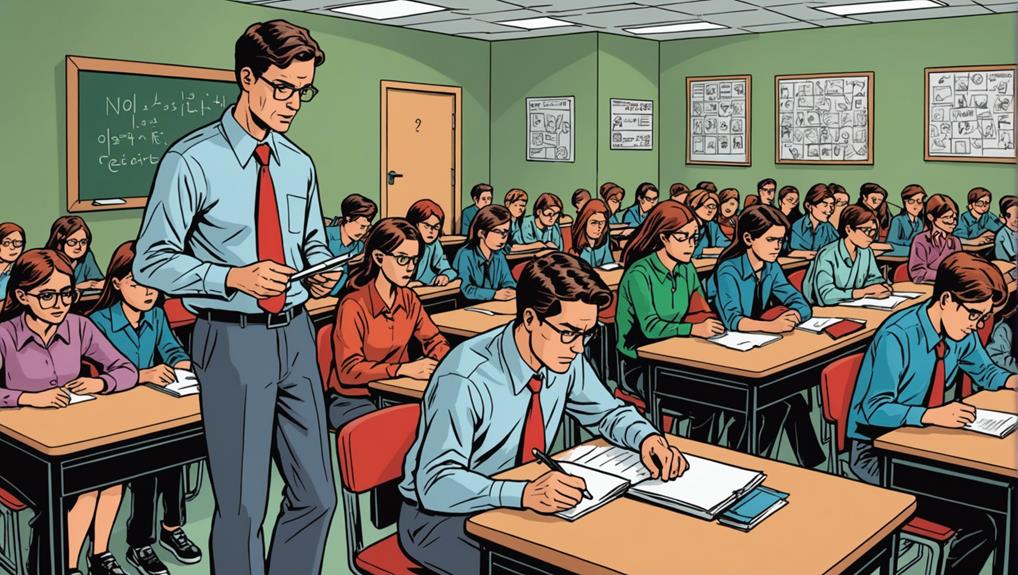Boosting student creativity relies heavily on educators who play a crucial role in nurturing innovative thinking and creating a vibrant learning atmosphere. Educators inspire students to think outside the box, problem-solve creatively, and explore new ideas fearlessly. By encouraging risk-taking, fostering collaboration, and modeling creativity themselves, teachers pave the way for students to develop essential skills for future success. Disrupting monotony through varied teaching methods, interactive activities, and embracing flexibility in lesson plans ignites students' curiosity and passion for learning. Educators hold the key to opening a world of creativity in students, guiding them towards a future filled with innovation and endless possibilities.
Key Takeaways
- Encourage risk-taking to foster creativity and innovation in students.
- Provide freedom for exploration within boundaries to spark creative thinking.
- Model creativity to inspire students to think outside the box.
- Foster collaboration to encourage diverse perspectives and enhance creative ideas.
- Play a pivotal role in cultivating creativity by nurturing and celebrating students' creative endeavors.
Importance of Creativity in Education

Enhancing creativity in education is paramount for fostering holistic student development and preparing them for the challenges of the future.
Creativity is not just about art; it involves thinking outside the box, problem-solving, and innovation. By nurturing creativity in students, educators are equipping them with essential skills that will be invaluable in their future careers and personal lives.
Creativity encourages individuals to explore new ideas, approach challenges with an open mind, and find unique solutions. In an ever-evolving world, where problems are complex and solutions require innovative thinking, fostering creativity in education is vital.
It paves the way for students to become adaptable, resourceful, and resilient individuals ready to tackle whatever comes their way.
Engaging Activities for Creativity

Fostering creativity in education involves implementing engaging activities that challenge students to think innovatively and explore diverse perspectives. Engage students with activities like brainstorming, storytelling, artistic projects, role-playing, and collaborative tasks. These activities expand creative thinking, boost mindfulness, and enhance awareness of their creative skills. To provide a quick overview of engaging activities, here is a table showcasing some popular options:
| Engaging Activities | Description | Benefits |
|---|---|---|
| Brainstorming | Generate creative ideas in a group setting | Encourages idea generation |
| Storytelling | Develops narrative skills and imagination | Enhances communication skills |
| Artistic Projects | Allows for self-expression through art | Stimulates creativity |
| Role-Playing | Encourages empathy and perspective-taking | Fosters understanding diversity |
Educator's Crucial Role

Educators play a pivotal role in cultivating creativity by creating a stimulating learning environment and offering support and encouragement to students.
Here are four key ways educators can enhance creativity in students:
- Encouraging Risk-Taking: Encouraging students to step out of their comfort zones and take risks fosters creativity and innovation.
- Providing Freedom for Exploration: Allowing students the freedom to explore their interests and ideas without fear of judgment can spark creativity.
- Fostering Collaboration: Encouraging collaborative projects and group work can inspire creative thinking through diverse perspectives.
- Modeling Creativity: By showcasing their own creative processes and problem-solving skills, educators can inspire students to think creatively.
Disrupting Monotony for Creativity

To enhance student creativity, the incorporation of breaks in routines, varying teaching methods, and introducing new topics and perspectives is essential. By disrupting monotony in the classroom, educators can inspire fresh ideas and innovative thinking among students.
Switching up the usual schedule with interactive activities, guest speakers, or even outdoor lessons can reignite students' passion for learning and spark their creativity. These breaks from the norm not only offer a mental refresher but also encourage exploration and curiosity.
Embracing flexibility in lesson plans and challenging students with dynamic questions can further stimulate their creative potential. Remember, a little change in routine can lead to big bursts of creativity!
Nurturing Creativity in Students

Nurturing creativity in students requires a holistic approach that encompasses both structured educational practices and opportunities for self-expression. To effectively foster creativity in students, educators can:
- Encourage Divergent Thinking: Inspire students to explore multiple solutions to a problem, promoting creativity and innovation.
- Provide Freedom within Boundaries: Offer guidelines while allowing room for creative exploration, empowering students to express themselves.
- Offer Constructive Feedback: Help students refine their creative ideas by providing positive criticism and guidance.
- Celebrate Creativity: Recognize and showcase students' creative work to boost confidence and motivation.
Frequently Asked Questions
How Can Technology Be Integrated to Enhance Student Creativity in Education?
Integrating technology in education to enhance student creativity involves utilizing tools like interactive software, virtual reality, and digital platforms for collaborative projects. Technology offers avenues for exploration, experimentation, and innovative learning experiences that can boost creativity in students.
What Are Some Unconventional Methods to Spark Creativity in Students?
To spark creativity in students, embrace unconventional methods like planting seeds of curiosity with thought-provoking riddles, fostering collaboration through escape room challenges, and encouraging abstract thinking with metaphorical puzzles.
How Can Educators Assess and Measure the Effectiveness of Creativity-Enhancing Activities?
Educators can assess creativity-enhancing activities through qualitative measures like observation, student reflections, and portfolio assessments. Quantitative methods such as surveys, pre and post-tests, and rubrics can also provide insights into students' creative growth and the effectiveness of implemented strategies.
What Are Some Strategies to Help Students Overcome Creative Blocks and Limitations?
Strategies to help students overcome creative blocks and limitations include encouraging experimentation, embracing failure as a learning opportunity, providing a supportive environment, offering diverse stimuli, promoting interdisciplinary learning, and fostering a growth mindset.
How Can Parents Support Educators in Fostering Creativity in Students at Home?
Parents can support educators in fostering student creativity at home by encouraging open-ended play, providing diverse materials for exploration, and engaging in creative activities together. Collaborating with teachers and reinforcing creativity values at home can enhance students' creative development.
Conclusion
In summary, fostering creativity in students is essential for their academic success and future prospects.
Educators play a pivotal role in nurturing imagination and out-of-the-box thinking among students.
By implementing engaging activities, disrupting monotony, and providing guidance and support, educators can empower students to tap into their creative potential.
Through a collaborative effort, educators and students can work together to shape the creative minds of tomorrow and thrive in a rapidly changing world.









